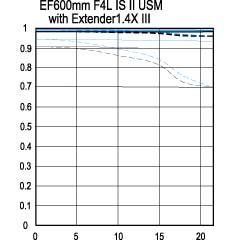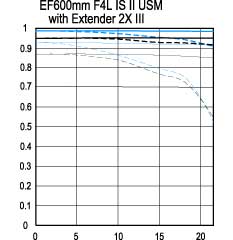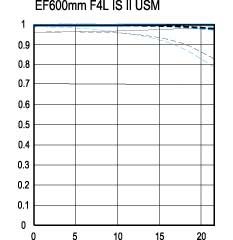
|
|||||||||||||||||||||||||||||||||||||||||||||||||||||||||||||||||||||||||||||||||||||||||||||||||||||||||||||||||||||||||||||||||||||||||||||||||||||||||||||||||||||||||||||||||||||||
| Focal Length & Maximum Aperture | 600mm f/4.0 |
| Lens Construction | 16 elements in 12 groups (Including drop-in rear filter, Fluorite: G2 and G4, UD Lens: None) |
| Diagonal Angle of View | 4°10' |
| Focus Adjustment | Inner focusing system, with focusing cam |
| Closest Focusing Distance | 4.5m / 14.77 ft. |
| Filter Size | 52mm Drop-In |
| Max. Diameter x Length, Weight | 6.6" x 17.6", 138.3 oz. / 168 x 448mm, approx. 3920g |
|
A quick guide to MTF charts (which only measure contrast and resolution. Canon's guide to their MTF charts)
|
||
| Canon EF 600mm | f/4L USM | f/4L IS USM | f/4L IS II USM | f/4L III USM |
|---|---|---|---|---|
| Key features | ||||
| Image stabilizer | No | Yes | ||
| Environmental sealing | Yes | |||
| Ultrasonic Motor | Yes | |||
| L-series | Yes | |||
| Technical data | ||||
| Focal length | 600 mm | |||
| Aperture (max/min) | f/4 / f/32 | |||
| Construction | 9 elements / 8 groups | 17 elements / 13 groups | 16 elements / 12 groups | 17 elements / 13 groups |
| # of diaphragm blades | 8 | 9 (circular aperture) | ||
| Closest focusing distance | 6 m (17.95 ft) | 5.5 m (16.45 ft) | 4.5 m (14.8 ft) | 4.2m (13.8 ft) |
| Max. magnification | 0.11x | 0.12x | 0.15x | 0.15x |
| Horizontal viewing angle | 3°30' | |||
| Vertical viewing angle | 2°20' | |||
| Diagonal viewing angle | 4°10' | |||
| Physical data | ||||
| Weight | 6000 g (212.4 oz) | 5360 g (189.8 oz) | 3920 g (138.8 oz) | 3050 g (6.73 lbs) |
| Maximum diameter | 167 mm (6.6") | 168 mm (6.6") | ||
| Length | 456 mm (17.9") | 448 mm (17.6") | ||
| Filter diameter | 48 mm (rear) | Any 52(WII)-series drop-in filter | 52(WIII) | |
| Accessories | ||||
| Lens case | ? | 600 | 600B | |
| Lens hood | ? | ET-160 | ET-160 (WII) | ET-160 (WIII) |
| Lens cap | ? | E-185 | E-185B | |
| Retail information | ||||
| Release date | November 1988 | Sept. 1999 | June 2011 | Sept. 2018 |
| Currently in production? | No | yes | ||
| prices | 923,000 yen | 1,290,000 yen (w/case and hood) | $11,499 | £12,999 |
EF 600mm f/4L IS II USM reviews and articles
- Canon UK / US Information Page
- Amazon
- Northlight Images
- Canon CPN article
- Fred Miranda
- Lens Tip
- Digital Picture
- PhotoZone
- SLR Gear
- Lens Review
- ePhotozine
- Blog - Grant Atkinson
Sample images
None available at present.
Product launch
Announced London, UK, 7th February 2011
Canon launches two new super-telephoto lenses for its leading EOS Digital SLR (DSLR) range – the EF 500mm F/4L IS II USM and the EF 600mm F/4L IS II USM.
Designed to meet the needs of the most demanding sports and wildlife photographers, both lenses offer breakthrough performance, delivering consistently high-quality images and incredible mobility. The launch of the models follows a development announcement in August 2010, and the display of prototypes at Photokina 2010 in Cologne, Germany.
Launching into Canon’s professional L-series, the models replace the widely-respected EF 500mm F/4L IS USM and EF 600mm F/4L IS USM, and are designed to achieve unparalleled levels of image quality. Each includes the highest-quality optics and the latest Canon Image Stabilizer (IS) technology, while magnesium alloy constructions with titanium components make each lens significantly lighter and even more durable. Launching as the lightest lens in its class*1, the EF 600mm F/4L IS II USM benefits from an exceptional 27% reduction (1.4kg) in weight compared to its predecessor, while the EF 500mm F/4L IS II USM offers an impressive reduction of 17% (680g).
New levels of performance
Both lenses feature completely redesigned optics, with 16 elements in 12 groups. Canon has over 40 years of experience in the manufacturing of fluorite lens elements, and has utilised two high performance fluorite elements in these lenses– delivering high resolution, high contrast shots rich in detail across the frame.
Both lens’ optical elements feature Canon’s Super Spectra Coatings and a SubWavelength Structure Coating (SWC), optimised to effectively reduce ghosting and flare. A water-repellent fluorine coating is also used on the surface of the front and rear elements, repelling dust and dirt for clearer shots, and keeping the front element free of marks by ensuring water droplets run off the lens quickly.
Enhanced IS, precise AF
Both models feature Canon’s latest Image Stabilizer system, offering outstanding image quality during handheld shooting and allowing users to shoot at speeds up to four times slower than normally required. IS Mode 2 features new algorithms to improve performance when panning, and the new IS Mode 3 is also included, assisting users when switching between subjects by activating the IS unit only during exposure.
Both lenses offer a constant f/4 aperture, allowing photographers to achieve excellent image quality in low light and capture clear, sharp shots of fast-moving subjects. The wide aperture also allows users to creatively isolate their subjects from the background, with a nine-blade circular iris creating beautiful background blur that instantly adds atmosphere to an image.
Rapid, quiet Auto Focus (AF) is provided by a ring-type Ultrasonic Motor (USM). Photographers can also utilise full-time manual focusing functionality, which enables the fine-tuning of focus even when the AF system is activated, providing even greater control over image capture. Power Focus mode also assists users during video shooting, allowing the photographer to smoothly adjust focus during filming by twisting the focus recall ring.
Premium L-series design
Both lenses have been designed as part of Canon’s renowned elite L-series, combining exceptional-quality optics with stylish designs. Both also feature a revised layout, with carefully-positioned controls that improve everyday operation. The AF stop buttons are now location-adjustable, improving ergonomics by allowing users to custom-select the position of the lens grip where the AF stop buttons are located.
Mechanical improvements include optional long or short foot tripod mounts suitable for monopods or tripods. An improved tripod collar rotational mechanism provides a smoother movement when turning the lens from portrait to landscape orientation, and a Kensington-type wire security lock has also been included, keeping the lenses secure during location-based shoots. The robust design is also weatherproof, making both lenses suitable for use in extreme conditions when paired with a weatherproof EOS body.
*1 According to Canon market research conducted in December 2010.
| Used Canon Lenses • UK: MPB | Park • USA: B&H | Adorama |
 |
| Welcome to EFLens.com: The world's number 1 Canon Review website with every Canon EF Lens. Read all of the reviews, see detailed specifications and check the price. • EF Lens chronology • EF Lens date codes • EF Lens mount details • EF Lens filter sizes • Compare EF-S18-55 versions • Tweet about it • Tell a friend • Send feedback |
 |
| Canon Lens List: • EFLens.com |
 |
| Sigma Lens List: • Manufacturer's Website |
 |
| Samyang/Rokinon List: • Manufacturer's Website |
 |
| Tamron Lens List: • Manufacturer's Website |
 |
| Tokina Lens List: • Manufacturer's Website |
 |
| © 1987 - 2019 NI |
 Canon EF 600mm f/4L IS II USM
Canon EF 600mm f/4L IS II USM



